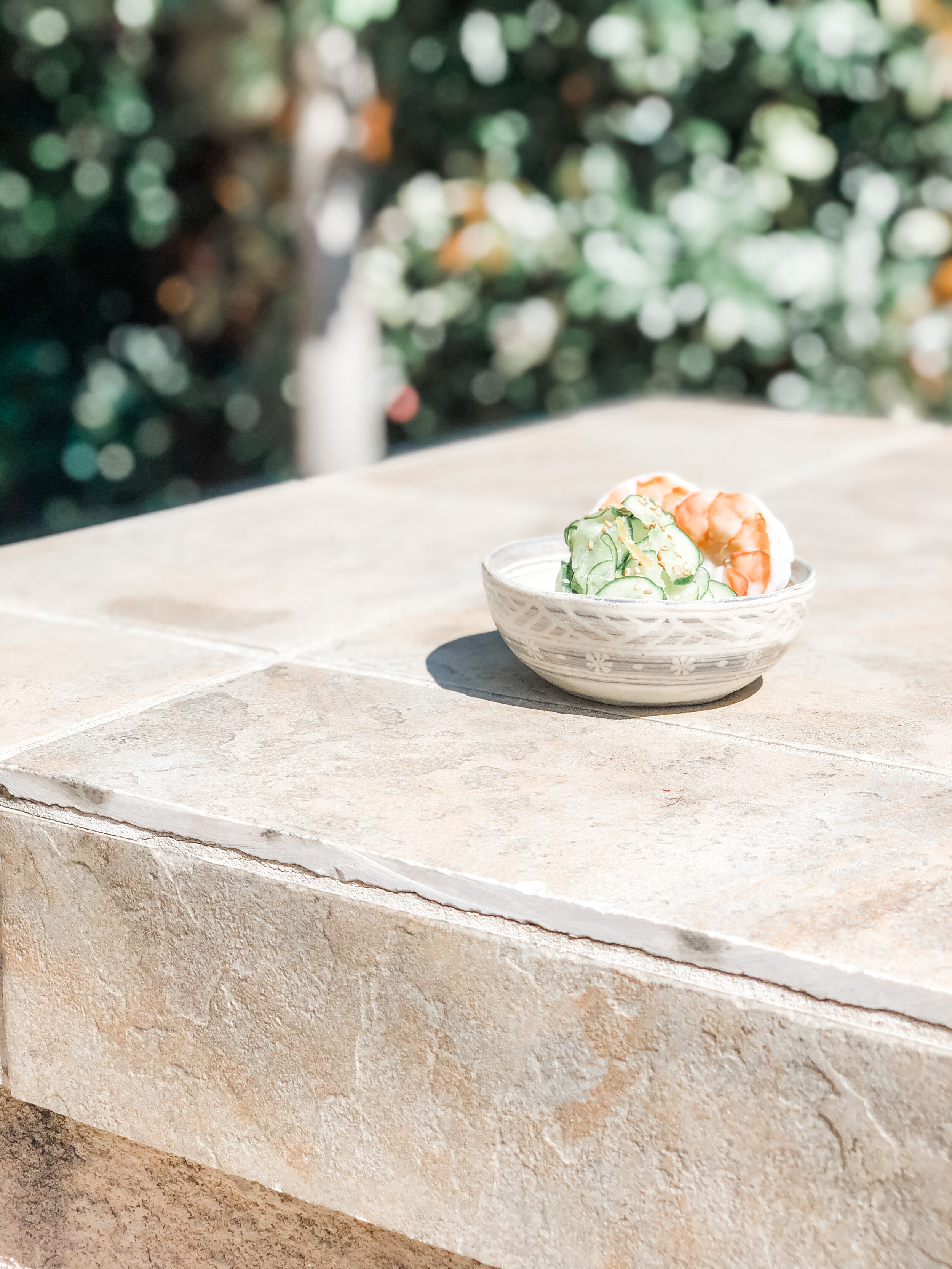Quick Recipe: Sunomono Cucumber Salad
Summer produce is my favorite. Going to the farmers market on Sundays, and seeing mounds of brightly colored tomatoes and peppers, new varieties of eggplant and summer squash, and sampling berries and melons bring so much joy and gratitude. They exude vibrance and bring back many childhood memories. While growing up, my family dog — a black Scottish Terrier named Angel — LOVED cherry tomatoes! She would pick them right off the vines in our backyard, without a care if they were ripe or completely green. She would throw them in the air, chase them, lay down on the grass, and then finally devour them.
But, there’s one particular summer produce that’s at the top of my summer produce short-list: cucumbers. Their crunchy texture, hydrating mouthfeel, and slight sweetness make them my go-to snack during the summertime. Whether tossing them into a salad, making flavored water, or simply eating them with a dab of miso (fermented soybean paste), cucumbers are an essential summer produce in my household.
Sunomono is a Japanese cucumber salad that’s frequently eaten as an appetizer in Japan. It’s a quick, salt-pickled salad that’s paired with a tangy rice vinegar dressing. During the summertime, the sunomono has a refreshing, cooling effect that will be enjoyed by you and your family. And on top of that, it’s super simple to make and versatile!
“Su” means “vinegar” and “mono” means “things” — so the word literally translates into “vinegared things.” In Japan, cucumber is the most common produce used in a sunomono, but shredded radishes and julienned carrots can be used as well. Sunomono can often be seen combined with shrimp (like today’s recipe), wakame seaweed, crab, or octopus.
In this recipe, I used Japanese cucumbers (called kyuri in Japan). They are long and slender with minimal seeds and thin skin and can be found in Japanese or Asian markets. If you can’t find them, good substitutes are the short Persian cucumbers or the long English cucumbers, which are often found shrink-wrapped at grocery stores. Other varieties — like the lemon, pickling, or garden cucumbers — have too many seeds and thick peels so I don’t recommend them for this recipe.
The dressing is super simple — only three ingredients! I use rice vinegar instead of apple cider or white vinegar because it has a milder, sweeter flavor. Red wine vinegar and champagne vinegar are also good substitutes; but if you haven’t tried rice vinegar, definitely give it a try. I often double (or triple) the dressing recipe and use the leftover for vinaigrettes in my future salads. Just add some extra virgin olive oil or sesame oil and you have yourself a vinaigrette for the rest of the week!
Japanese ‘Sunomono’ Cucumber Salad with Shrimp and Sesame Seeds
Ingredients (Serves 4)
Cucumber Salad:
2 Japanese cucumbers/kyuri* substitute with one English or four Persian cucumbers
2-inch piece of lemon rind
1/2 teaspoon of sea salt
8 medium-sized shrimp* peeled and deveined
1 teaspoon of toasted sesame seeds
Dressing:
4 tablespoons of rice vinegar
1 teaspoon soy sauce or tamari
1 teaspoon of granulated sugar
Directions
Slice the cucumbers as thin as you can. If you have a mandoline, it will be much faster.
Gently slice a 2-inch piece of lemon rind. Using a small paring knife would be helpful. Make sure to only get the yellow portion of the rind and avoid the white pith, which is bitter and soapy in flavor. Then thinly slice the lemon rind.
In a medium-sized bowl, add the sliced cucumbers, lemon rind, and salt. Mix and gently squeeze everything together with your hand until evenly incorporated. Cover with plastic wrap and set aside for 15-25 minutes. The salt will remove excess water from the cucumber, making them crunchier and more concentrated in flavor.
In the meantime, add the soy sauce, rice vinegar, and granulated sugar in a small bowl and mix until incorporated.
Heat a small pot of water, and peel the shrimp. Remove their intestinal tract by making a shallow cut lengthwise along the back with a paring knife. Using the tip of the knife, lift and remove the dark-colored intestinal tract and dispose. Place in boiling water for one minute or until vibrant orange and firm. Transfer the cooked shrimp to an ice bowl. This will stop the cooking process, preserve their vibrant color, and prevent the shrimp from becoming chewy.
After 15-25 minutes, squeeze the excess water out of the cucumbers and place them in a separate bowl. Discard excess water.
Divide the seasoned cucumbers and cooked shrimp into 4 small plates/bowls. Drizzle the dressing on the cucumbers and shrimp. Top with the toasted sesame seeds.
Other topping ideas include freshly grated ginger, a drizzle of sesame oil, crab meat, sashimi-grade sliced octopus, and wakame seaweed.
Tadashi Oguchi is the Culinary and Nutrition Coordinator at Recovery Cafe in downtown San Jose, which supports people experiencing trauma from addiction, homelessness and mental health challenges. As a certified health coach, he is passionate about educating his community about healthy cooking and utilizing food as medicine to prevent/reverse chronic diseases. He’s a cat dad to two tabby cats — Colby and Lynx. While sheltering in place, he’s learned to bake naturally-leavened breads, jammed on his ukulele, and attempted to cut his hair — twice.




